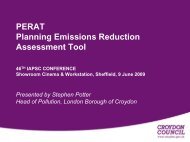Cars and behaviour: psychological barriers to car restraint ... - iapsc
Cars and behaviour: psychological barriers to car restraint ... - iapsc
Cars and behaviour: psychological barriers to car restraint ... - iapsc
You also want an ePaper? Increase the reach of your titles
YUMPU automatically turns print PDFs into web optimized ePapers that Google loves.
Moni<strong>to</strong>ring <strong>and</strong> evaluation of <strong>behaviour</strong>al programmes<br />
Peter Wilbers (SenterNovem) <strong>and</strong> Luc Wismans, Robert Jansen (Goudappel Coffeng)<br />
Introduction<br />
There is a growing need for government<br />
programmes that aim at changing<br />
consumers’ <strong>behaviour</strong> <strong>to</strong> moni<strong>to</strong>r the output<br />
of activities. In assessing programme<br />
resources, activities <strong>and</strong> objectives<br />
systematically, government interventions<br />
can be evaluated <strong>and</strong> adjusted periodically.<br />
In this paper we show how the results of<br />
<strong>behaviour</strong>al programmes can be assessed by<br />
the application of moni<strong>to</strong>ring methods. We<br />
will discuss the development <strong>and</strong><br />
construction of a moni<strong>to</strong>ring method. The<br />
importance of moni<strong>to</strong>ring government<br />
programmes is stressed with regard <strong>to</strong> longterm<br />
policy making <strong>and</strong> review. The<br />
Netherl<strong>and</strong>s ECO-DRIVING programme<br />
‘Het Nieuwe Rijden’ is used <strong>to</strong> demonstrate<br />
how moni<strong>to</strong>ring <strong>and</strong> evaluation of<br />
<strong>behaviour</strong>al programmes can be performed.<br />
Why moni<strong>to</strong>r <strong>behaviour</strong>al programmes?<br />
There are several strategic reasons for moni<strong>to</strong>ring<br />
<strong>behaviour</strong>al programmes:<br />
1. These programmes are often characterised by longterm<br />
objectives <strong>and</strong> activities. They combine<br />
sizeable <strong>and</strong> structural investments with several<br />
packages of programme activities. The ECO-<br />
DRIVING programme for example, lays the<br />
foundation for a substantial reduction of CO2<br />
emissions in the long term.<br />
2. Behavioural programmes function in a highly<br />
complex environment. They involve many<br />
stakeholders such as consumer <strong>and</strong> retail<br />
organisations.<br />
3. The programmes focus on <strong>behaviour</strong>al change.<br />
Behavioural change relates <strong>to</strong> many fac<strong>to</strong>rs. Often,<br />
there are uncertainties about the persistence of the<br />
<strong>behaviour</strong>al effects. By moni<strong>to</strong>ring, a clear<br />
underst<strong>and</strong>ing of these effects can be obtained.<br />
In moni<strong>to</strong>ring the ECO-DRIVING programme<br />
consistently, SenterNovem was able <strong>to</strong> prove the<br />
effectiveness of the programme. Consequently policy<br />
makers approved a continuation of the ECO-DRIVING<br />
programme.<br />
The Netherl<strong>and</strong>s ECO-DRIVING programme<br />
In the Netherl<strong>and</strong>s the Ministry of Transport<br />
<strong>to</strong>gether with the Ministry of Environment<br />
initiated the ECO-DRIVING programme ‘Het<br />
Nieuwe Rijden’ The programme is implemented<br />
by SenterNovem, an agency of the Ministry of<br />
Economic Affairs, in co-operation with a large<br />
number of consumer <strong>and</strong> retail organisations.<br />
The programme’s main objective is the<br />
reduction of CO2<br />
emissions. It aims at<br />
influencing driving style, checking tyre<br />
pressure, <strong>car</strong> purchase <strong>and</strong> the use of in-<strong>car</strong><br />
devices.<br />
The programme activities <strong>and</strong> results are being<br />
evaluated on a yearly basis. For this purpose a<br />
moni<strong>to</strong>ring method has been developed. It<br />
comprises sets of indica<strong>to</strong>rs <strong>and</strong> measurement<br />
procedures for data collection as well as<br />
computational <strong>and</strong> decision rules for the<br />
assessment of <strong>behaviour</strong>al effects <strong>and</strong> the<br />
overall evaluation of the programme.<br />
Why moni<strong>to</strong>ring?<br />
The general objective of moni<strong>to</strong>ring relates <strong>to</strong> ‘quality’ <strong>and</strong> ‘control’ of the processes that are<br />
being moni<strong>to</strong>red. It implies that moni<strong>to</strong>ring relates <strong>to</strong> the policy making process. In fact,<br />
moni<strong>to</strong>ring can be seen as a <strong>to</strong>ol in<br />
guiding management. Moni<strong>to</strong>ring<br />
not only provides insight in<strong>to</strong> the<br />
processes under study. It points out<br />
possible problems as well. In case<br />
an intervention turns out not <strong>to</strong> have<br />
the desired result, it is possible <strong>to</strong><br />
make timely adjustments.<br />
Moni<strong>to</strong>ring provides information<br />
about the progress of policy<br />
implementations. It is a means <strong>to</strong><br />
account for the cost-effectiveness<br />
<strong>and</strong> efficiency of policy<br />
interventions (‘Is the money well<br />
spent?’). It allows outcomes of<br />
government programmes <strong>to</strong> be<br />
evaluated at different levels; i.e.<br />
outcomes of project activities <strong>and</strong><br />
the overall outcome of a<br />
programme. Moni<strong>to</strong>ring information<br />
can be used for communication<br />
purposes as well.










